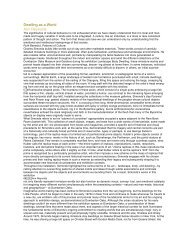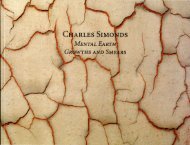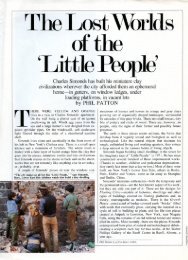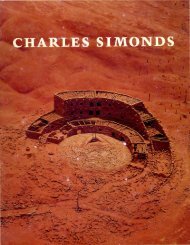of adventures. The Little People were accepted sowarmly that they stayed there and multiplied. "Simonds studied the behavior of the environment thatbegan to involve itself with this sandbox creation: "Myrole gradually changed. At first, I was only a crazyfellow without identity for the people of the LowerEast Side. I was an attraction, an anonymous vagabondwho made chimerical things. "It very rapidly became apparent that work of this type,which combined aesthetic finesse with direct intervention,had nothing autistic about it. The formal richnessof Simonds' miniature structures was obvious, and itsuggested a multiplicity of interpretations. The effectof the Dwellings relied strongly on a contrast with thesetting in which they were shown. The tiny, abandoneddream settlements clashed with the overcrowded,vertical megalopolis, and astonishingly, their vulnerabilitycalled its massed dynamism in question. This characteristicfeature came out even more clearly in certainlater projects, like the compelling Basel piece in whichThree Trees pierced the glass box of the museum architecturefrom bottom to top. Another spectacular formulationwas found in Age, where Simonds placed a greatmountain in the middle of the Guggenheim Museumfoyer to oppose its shell-like convexity. A third case inpoint is the work installed in a railroad tunnel nearNiagara Gorge, in Lewiston Art Park, State of New York.·~, .. J, ;.;:.. i--'- ......As such examples illustrate, Simonds' art relates just asmuch to site construction as to do the approaches ofRichard Long, Dennis Oppenheim, Robert Smithson, orMichael Heizer. His Dwellings function within a preciselydefined, specific context. And this context, rather thanbeing that of archaeological grave-excavation, Pompeiior Yucatan or the mesas, is that of the modern metropoliswith its acute sense of time, in which every notionof transience is obviated by the hectic business of living.Simonds' emergence from the private sphere to thepublic street may have spoken for spontaneity. Yet historically,his approach can be seen to partake of the artificialtime systems thanks to which the relic-gatherersand mythologists in recent art have been able to settheir parallel worlds in opposition to the pragmatismand belief in progress of contemporary age. Such auto-«Age", Solomon R. Guggenheim Museum, New York, 198313
le progres. Des microsystemes autoreferentiels de cegenre, on en a vu apparaltre partout dans le domaine del'art conceptuel ace moment-la. Globalement, ils releventd'un rationalisme post-duchampien dont le modele seraitpeut-etre fourni par Trois Stoppages-eta/on, ces formesaleatoires accompagnees d'un instrument de mesure,ces fruits du hasard isoles, maintenus a l'ecart de leurpropre contingence.Parmi tous les documents relatifs au travail de CharlesSimonds, il en est deux qui me semblent particulierementeclairants. Le premier est un photogramme extraitde Birth, un film de trois minutes qui no us ramene audebut de sa carriere.demiurge jouant avec l'univers sur son ventre. D'autresceuvres renvoient a Ia fertilite de Ia terre, a Ceres ou auxdieux-fleuves de l'antiquite. Parfois, !'artiste va jusqu'asemer des graines. La semence germe et se transmueen pourvoyeuse de nourriture.L'erotisation des formes et des gestes, l'emprise libidineusesur l'environnement vehiculent un message evident.La, I' expression spontanee se double d'une prisede position culturelle. Le langage corpore! rudimentaireenregistre dans Birth ne traduit pas seulement le desirde s'identifier avec un paradis maternel. II signale unlien avec l'expressionnisme abstrait. Les gestes intuitifssont censes montrer ou mettre !'artiste dans un etat ou ilExtraits du film I Extracts from the film «Birth», 1970Simonds a tourne ce court -metrage en 1970 avec unecamera fixe, dans une glaisiere du New Jersey. L'etrangeliturgie enregistree dans Birth pose les fondements detoute l'ceuvre ulterieure de !'artiste. Loin de se limitera proposer une autre variante du body-art ou des techniquesd'auto-exploration si courantes a l'epoque, lefilm donne Ia justification profonde de l'ceuvre. II reveleles premiers efforts de I' artiste pour penetrer physiquementdans l'univers de Ia representation. Nous assistonsa un rite du printemps, a I' evocation d'une renaissanceau sortir du magma originel. Ce rituel gestuel tient del'accomplissement du desir. Le corps s'immerge sansretenue dans Ia profusion universelle.II n'est peut-etre pas inutile de rappeler ici que Ia terminologiefreudienne a joue un role considerable et redoutabledans l'enfance et !'adolescence de Simonds.II y fait allusion au cours de son entretien avec DanielAbadie : " Les Little People ont leur origine dans mesfugues d'enfant pour echapper a mes parents, a moneducation, celle d'un fils de psychanalystes de I'Ecolede Vienne." L'une des principales analogies avec Iatheorie de Freud reside bien evidemment dans l'archeologie,dans l'attirance pour Ia ruine, dans le travail derestitution axe sur Ia mise au jour des strates de souvenirsenfouis.La glaise d'ou Simonds surgit dans le film allait devenirpar Ia suite l'unique matiere premiere de son art. L'artistele souligne lui-meme : "Dans ma mythologie personnelle,je suis ne de Ia terre et une bonne partie de mes ceuvresvisent a rappeler ce fait, a le formuler aux autres eta moi-meme. LandscapeBodyDwelling est unemetamorphose du paysage en corps, du corps en paysage."Les freles Dwellings d'argile renvoient par consequenta des formes du corps humain, notamment Ia poitrineet le sexe de Ia femme. lis deviennent autant derefuges dans un corps-paysage feminin . " Les sculpturesde Simonds, note Diane Waldman, ont egalementun caractere organique, une forme et un contenu ero tiques. Sous ce rapport, son ceuvre fait penser a cellede Claes Oldenburg, dont l'idee d'erotiser l'environnementsemblait extremement novatrice dans les anneessoixante."Chez Simonds, le panerotisme sculptural se manifestedans diverses ceuvres, comme Number 9 (RitualGarden), Ground Bud ou Stone Sprout, ou le materiausemble aspire ou ingere. Dans une autre ceuvre ceremonielle,BodyEarth, un corps etendu se pressecontre le sol. Ce theme est repris et developpe dansLandscapeBodyDwelling, par exemple, ouSimonds projette une image de son monde en miniaturesur son corps entierement couvert de glaise, surfacevivante enduite du materiau de Ia nature, tel uns'affranchit des contraintes historiques pour permettrea des forces metaphysiques de s'exprimer a travers lui.De meme, les gestes impulsifs des expressionnistesabstraits etaient censes les liberer des presupposessociaux-historiques. En regardant les mouvementsdansants de Simonds dans le film Birth, Ia far,;on dont Iachoregraphie le fait emerger peu a peu de Ia boueargileuse, on songe machinalement a celui qui fut le premiera s'offrir en spectacle sur le meme mode solennel,Jackson Pollock. Hans Namuth a fixe sur Ia pelliculecette etrange gestuelle. Pollock, en proie a une sorte detranse rythmee, se laissait absorber par son tableau.La presence de Ia camera avait le don d'accelerer encoreIa cadence de ses mouvements. Birth s'apparente,par-dela Pollock et l'ecriture automatique des surrealistes,aux rites d'initiation de Ia periode romantique.Le deuxieme document eclairant que j'ai retenu produitune tout autre impression. C'est une photographie montrantIa tete et Ia main de !'artiste, une image de concen-14
- Page 2: Galerie Enrico Navarra
- Page 8 and 9: Preface. Enrico NavarraForeword. En
- Page 10 and 11: Le Monde dans le monde. Werner Spie
- Page 14 and 15: eferential microsystems were in wid
- Page 16 and 17: •LandscapeBodyDwellin9", 1970Char
- Page 18 and 19: in which Raquel Welch accompanies A
- Page 20 and 21: •Picaresque Landscape•, 1976, i
- Page 22: I Remember... Jean-Louis PratI reme
- Page 26 and 27: Ritual Place, 1970Argile et bois13
- Page 28 and 29: Labyrinth, 1972Argile et bois30x63x
- Page 31: 32Pyramid, detail I detail, 1972
- Page 34 and 35: elieved in a world entirelywould be
- Page 36 and 37: Circles and Towers Growingno11, 197
- Page 39: Dwelling, details, 1981Argile et bo
- Page 44 and 45: Age, 1983Argile, platre et bois310
- Page 47 and 48: Flying Smear, 1983Argile, bois et p
- Page 49 and 50: Wilted Towers, 1984Argile et bois30
- Page 53 and 54: Rocks no 1 , 1984Rocks No. 1, 1984T
- Page 55 and 56: Stump, 1984Argile et bois35,5 x 61
- Page 57 and 58: Pod no 2, 1984Argile et bois29,2 x
- Page 60 and 61: Leaves, 1986Argile et bois15x61 x61
- Page 62 and 63:
Smear, 1986Argile et bois15,2 x 76,
- Page 66:
Rocks, 1988Rocks, 1988Spirit Rocks,
- Page 69 and 70:
Pyramid, 1991Argile, platre et bois
- Page 71 and 72:
Dwelling, 1991Argile et boisBriques
- Page 73 and 74:
Head, 1993Argile, platre et bois67,
- Page 75 and 76:
Tumbleweed, 1993Porcelaine20,5 x 20
- Page 77 and 78:
I, Thou, 1993Argile et ciment37,5x2
- Page 79 and 80:
Man and Fish, 1993Argile et bois25
- Page 82:
82Growth House, detail I detail, 19
- Page 85 and 86:
Maze, 1998 Maze, 1998Argile et bois
- Page 87 and 88:
Houseplant no 2, 1998Houseplant No.
- Page 90 and 91:
Long Rocks, 2000Argile, platre et s
- Page 92:
Sans titre, 2001Argile. platre et t
- Page 98 and 99:
Charles Simonds, 1950 «Rabbit Read
- Page 100 and 101:
Greene Street Dwelling, New York, 1
- Page 102 and 103:
••Excavated and Inhabited Railr
- Page 104 and 105:
Charles Simonds travaillant I worki
- Page 106 and 107:
«Dwelling•, Whitney Museum, New
- Page 108 and 109:
Desert en fleur, Nouveau-Mexique I
- Page 110 and 111:
Travaillant sur «Age .. I Working
- Page 112 and 113:
«Passage .. , 1989, Centre Georges
- Page 116 and 117:
Expositions I ExhibitionsExposition
- Page 118 and 119:
-"9th Biennale de Paris", Musee d'A
- Page 120 and 121:
charles simondsSculpture Since 1940
- Page 122 and 123:
Simonds), Cologne, Germany, Verlag
- Page 124 and 125:
Kind, Joshua- "Charles Simonds: An
- Page 126 and 127:
125
- Page 128:
Edite par I Published by: Galerie E












